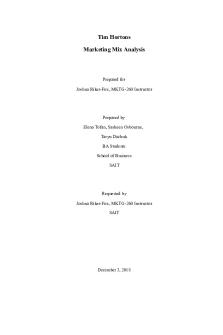Tim Hortons Report - Lecture notes 1 PDF

| Title | Tim Hortons Report - Lecture notes 1 |
|---|---|
| Author | Samrina Haq |
| Course | International Business Environment |
| Institution | University of South Wales |
| Pages | 6 |
| File Size | 169.8 KB |
| File Type | |
| Total Downloads | 61 |
| Total Views | 148 |
Summary
abc...
Description
TIM HORTON’S REPORT
Table of Contents
1.
Introduction........................................................................................................................2
1.1. 2.
Company Goals...............................................................................................................2 Overview of company’s History........................................................................................2
2.1. 3.
Product Categories....................................................................................................2
Forecasting Approaches.....................................................................................................3 3.1.
Qualitative Approach................................................................................................3
3.2.
Quantitative Forecasting Approach.........................................................................3
3.2.1.
Forecasting of Food............................................................................................3
1. Introduction Tim Horton’s is an international restaurant chain, was founded in Ontario, Canada. It has 4014 outlets out of which around 99% of them are licensed. It is one of the most successful running restaurant chain with the revenues of over $28521 Million in the year 2011. Tim Horton’s has exceeded from MacDonald’s as the largest food service operator in Canada.
1.1. Company Goals The goal of the Restaurant is to offer best quality products and services for every customer and community. It is aimed in the vision statement of the company to become the quality leader in everything they do.
2. Overview of company’s History In 1964, Tim Horton started a restaurant chain and gave it his name. To insure the incomes after his playing days has ended. He opened a donut shop. In 1967, Ron Joyce became his partner in his business. After the death of Tim Horton in 1974, Ron Joyce became the sole proprietor of the business. He aggressively extended the number of restaurants and opened 500th restaurant in 1991. Another partner named Wendy acquired Tim Horton in 1995. His mission was to deliver high quality food and unmatchable service to customers, which have been the key to their success. In 2006, Joyce became the largest shareholder in Tim Horton restaurant chain. It is now a publicly traded company by the name “Tim Horton’s. Inc.” It also made a partnership with cold stone creamery Kahala Corp., which is the ice-cream parlour to co-brand 100 stores in USA. This project was successful. According to the annual reports of 2011, Tim Horton’s is planning to open 300 more stores in next 3 years.
2.1.
Product Categories
It is currently the largest chain in Canada. It has been doing a great business in other countries as well. It has a variety of products to appeal vast range of customers’ preferences at affordable prices. The product line consists of premium coffee, flavoured cappuccinos, espresso, fruit smoothies, teas, soups, sandwiches, wraps, baked goods, and donuts. Apart from selling from restaurants, it also sells products in the form of coffee packets, Christmas hampers, and coffee vending machines in grocery stores.
3. Forecasting Approaches Forecasting is a very important technique for any company to analyse the future sales and make necessary procedures for it. It analyse the cost of short-term and long-term needs based on historical data. Forecasting can be used in scheduling employees, planning food, order management efficiency control, and marketing efforts management as well. Forecasting can involve quantitative and qualitative approaches.
3.1.
Qualitative Approach
Qualitative forecasting approach is important when the historical data is not available. It depends on the customer’s judgement, intuition and the timely opinions and preferences in terms of food and services. The Qualitative approach is categorized in to different categories:
Sales force composite
Delphi method
Consumer market survey.
Executive jury opinions
3.2.
Quantitative Forecasting Approach
Quantitative approach is used when adequate historical data is available. Based on the numeric figures the future need can be analysed. It also falls into different categories.
3.2.1. Forecasting of Food This forecast can be used for the analysis of food, supplies etc. Through it, the purchase quantity can be calculated. The yield factor should be known to calculate the amount of sale in terms of food. It is calculated by total sales over product used per week. All inventory is changed to units/purchase units before ordering.
Many other approaches can be used. Like:
Moving Average method
Adjustment method
Time Series analysis
Product cost analysis...
Similar Free PDFs

Tim Hortons Report
- 9 Pages

Tim hortons 1&2
- 5 Pages

04-Tim Hortons-Case Study
- 2 Pages

Tim Hortons Case - Grade: B
- 4 Pages

Étude de cas-Tim hortons Version 3
- 19 Pages

FIL Report - Lecture notes 1
- 1 Pages

Lab 1 Report - Lecture notes l1r
- 10 Pages
Popular Institutions
- Tinajero National High School - Annex
- Politeknik Caltex Riau
- Yokohama City University
- SGT University
- University of Al-Qadisiyah
- Divine Word College of Vigan
- Techniek College Rotterdam
- Universidade de Santiago
- Universiti Teknologi MARA Cawangan Johor Kampus Pasir Gudang
- Poltekkes Kemenkes Yogyakarta
- Baguio City National High School
- Colegio san marcos
- preparatoria uno
- Centro de Bachillerato Tecnológico Industrial y de Servicios No. 107
- Dalian Maritime University
- Quang Trung Secondary School
- Colegio Tecnológico en Informática
- Corporación Regional de Educación Superior
- Grupo CEDVA
- Dar Al Uloom University
- Centro de Estudios Preuniversitarios de la Universidad Nacional de Ingeniería
- 上智大学
- Aakash International School, Nuna Majara
- San Felipe Neri Catholic School
- Kang Chiao International School - New Taipei City
- Misamis Occidental National High School
- Institución Educativa Escuela Normal Juan Ladrilleros
- Kolehiyo ng Pantukan
- Batanes State College
- Instituto Continental
- Sekolah Menengah Kejuruan Kesehatan Kaltara (Tarakan)
- Colegio de La Inmaculada Concepcion - Cebu








